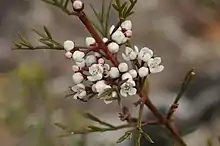Boronia occidentalis
Boronia occidentalis, commonly known as the rock boronia, is a plant in the citrus family Rutaceae and is endemic to eastern Australia. It is an erect, woody shrub with pinnate or bipinnate leaves and groups of up to three white to pale pink, pink four-petalled flowers arranged in leaf axils.
| Rock boronia | |
|---|---|
 | |
| Boronia occidentalis near Baradine | |
| Scientific classification | |
| Kingdom: | Plantae |
| Clade: | Tracheophytes |
| Clade: | Angiosperms |
| Clade: | Eudicots |
| Clade: | Rosids |
| Order: | Sapindales |
| Family: | Rutaceae |
| Genus: | Boronia |
| Species: | B. occidentalis |
| Binomial name | |
| Boronia occidentalis | |
 | |
| Occurrence data from Australasian Virtual Herbarium | |
Description
Boronia occidentalis is an erect, woody shrub that grows to a height of about 1 m (3 ft). It has pinnate or bipinnate leaves with between three and seven leaflets. The leaf is 9–25 mm (0.4–1 in) long and 7–25 mm (0.3–1 in) wide in outlines, on a petiole 3–7 mm (0.1–0.3 in). The end leaflet 1–4 mm (0.04–0.2 in) long and 0.5–1 mm (0.02–0.04 in) wide and the side leaflets are similar but longer. The flowers are white to pale pink and are arranged singly or in groups of up to three in leaf axils on a peduncle 0.5–2 mm (0.02–0.08 in) long. The four sepals are triangular, 1–2.5 mm (0.04–0.1 in) long and 0.5–2 mm (0.02–0.08 in) wide. The four petals are 2–3 mm (0.08–0.1 in) long. The eight stamens are hairy on their edges and the stigma is tiny, no wider than the style. Flowering mainly occurs from July to January and the fruit is a capsule 2–2.5 mm (0.08–0.1 in) long and about 1.5 mm (0.06 in) wide with the petals remaining.[2][3]
Taxonomy and naming
Boronia occidentalis was first formally described in 2003 by Marco F. Duretto from a specimen collected in the Wondul Range National Park and the description was published in Muelleria.[2][4] The specific epithet (occidentalis) is a Latin word meaning "western",[5] alluding to the fact that in most places, this species has a more westerly distribution than that of other boronias.[2]
Distribution and habitat
The rock boronia is one of the most widespread boronias and is found between Mount Sturgeon near Hughenden in north Queensland and Dubbo in New South Wales. It mostly grows in woodland on sandstone or in sandy soil.[2][3]
Conservation
Boronia occidentalis is listed as "least concern" by the Queensland Government Department of Environment and Science.[6]
References
- "Boronia occidentalis". Australian Plant Census. Retrieved 14 March 2020.
- Duretto, Marco F. (2003). "Notes on Boronia (Rutaceae) in eastern and northern Australia" (PDF). Muelleria. 17: 36–40. Retrieved 9 February 2019.
- "Boronia occidentalis". Royal Botanic Garden Sydney. Retrieved 9 February 2019.
- "Boronia occidentalis". APNI. Retrieved 9 February 2019.
- Brown, Roland Wilbur (1956). The Composition of Scientific Words. Washington, D.C.: Smithsonian Institution Press. p. 807.
- "Boronia occidentalis". Queensland Government Department of Environment and Science. Retrieved 9 February 2019.